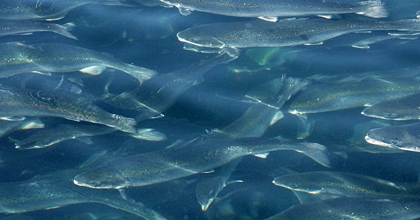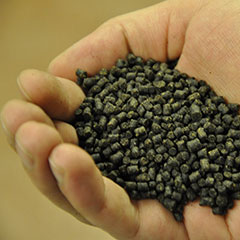Contact
Department of Applied Animal Science and Welfare, Aquakultur
Torbjörn Lundh, Professor
Department of Animal Nutrition and Management, SLU
torbjorn.lundh@slu.se, +46 18-672137

The overall aim is to evaluate local and alternative feeds on growth and health aspects of farmed fish and shrimp.
Project Managers: Anders Kiessling and Torbjörn Lundh
Researchers and PhD Students: Kartik Baruah, Aleksandar Vidakovic.
Aquaculture, farming of aquatic animals and plants, is the fastest growing food production industry and has recently matched wild catch from fisheries. Salmonids, such as rainbow trout (Oncorhynchus mykiss) and Arctic charr (Salvelinus alpinus), as well as other carnivorous fish, such as Eurasian perch (Perca fluviatilis), require high levels of protein in their diet to maintain adequate growth.

A fish farm. Photo: Aleksandar Vidakovic, SLU.
We specialise in numerous research techniques, such as sequencing of fish gut microbiota and dorsal aorta cannulation surgery for repeat blood sampling. These techniques allow us to investigate impacts of novel feed sources on growth and welfare indicators, such as beneficial microbial populations, postprandial blood changes, amino acid uptake, immune function and stress response. For more information, please see these links on the SLU-network for DNA barcoding and collaboration with the University of Gothenburg on the Fish REaring and Stress Hazards (FRESH) project.
Soy and fish meals are currently used as main protein sources in these diets, but these commodities are limited due to increased demand from humans. Microbes, such as baker's yeast (Saccharomyces cerevisiae) and micro fungi (Rhizopus oryzae), and molluscs, such as blue mussels (Mytilus edulis), are gaining attention due to their ability to convert nutrients from waste substrates into high quality protein. However, there is a lack of research that adequately assesses the impact of novel protein sources on fish health and nutrition.
Our research group aims to evaluate feed utilization efficiency, welfare, gut physiology and food safety implications when feeding alternative protein sources to trout, charr and perch. This research is divided into several projects (see below) and involves multiple collaborations between departments at SLU, Gothenburg University, Södertörn University, Stockholm University, Norwegian University of Life Sciences, Finnish Game and Fisheries Research Institute, An Giang University (Vietnam), Marine Aquaculture Research and Development Center (Cambodia), University of Queensland(Australia), University of Rwanda (Rwanda) och University of Dar es Salaam (Tanzania).
 Farmed rainbow trout. Photo: Aleksandar Vidakovic, SLU.
Farmed rainbow trout. Photo: Aleksandar Vidakovic, SLU.
These international research projects aim to develop sustainable aquaculture feeds and improve farmed fish welfare in efforts to support the growth of the aquaculture industry in supplying food to meet the demands of the growing human population.
Sustainable aquaculture in Rwanda - Evaluation of local feed ingredients for Nile tilapia Oreochromis niloticus (Leon Niyibizi, 2023)
Alternative feed to fish - Bioactive components effect
on metabolism and the gut micro flora (Aprajita, 2023)
Nutritive value and use of locally available low-cost feed ingredients for tilapia farming in Tanzania (Francis Pius Mmanda, 2020)
Evaluation on brewery yeast and insect meal (black soldier fly and cricket meal) to replace trash fish in the diet for Asian seabass (Lates calcarifer) in Cambodia (Sen Sorphea, 2019)
Microbial protein as replacement for fishmeal in diet to tilapia (Oreochromis niloticus) and freshwater prawns (Macrobrachium rosenbergii) (Nhi Nguyen Huu Yen; 2019)
Effects of feeding yeasts on blood physiology and gut microbiota of rainbow trout (David Huyben; 2017)
Single cell protein in fish feed: effects on gut microbiota (Andreas Nyman; 2016)
Fungal and mussel protein sources in fish feed: nutritional and physiological aspects (Aleksandar Vidakovic; 2015)
Nutrition of Arctic charr (Salvelinus alpinus) and Eurasian perch (Perca fluviatilis) and evaluation of alternative protein sources (Markus Langeland; 2014)
Digestion and Metabolism of Carbohydrates in Fish (Rani Abro; 2014)
Evaluation of locally available feed resources for striped catfish (Chau Thi Da; 2013)
Evaluation of local feed resources for hybrid catfish in smallholder fish farming systems in central Vietnam (Nguyen Duy Quynh Tram; 2010)
On-farm feed resources for catfish (Clarias gariepinus) production in Laos (Oudom Phonekhampheng; 2008)

Rainbow trout, arctic charr, pike perch, perch, tilapia, baramundi, fresh water prawns and blue mussels.
Torbjörn Lundh, Professor
Department of Animal Nutrition and Management, SLU
torbjorn.lundh@slu.se, +46 18-672137